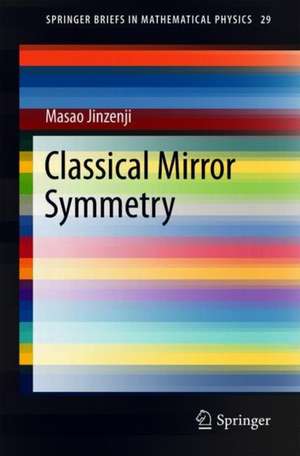Classical Mirror Symmetry: SpringerBriefs in Mathematical Physics, cartea 29
Autor Masao Jinzenjien Limba Engleză Paperback – 26 apr 2018
This book furnishes a brief introduction to classical mirror symmetry, a term that denotes the process of computing Gromov–Witten invariants of a Calabi–Yau threefold by using the Picard–Fuchs differential equation of period integrals of its mirror Calabi–Yau threefold. The book concentrates on the best-known example, the quintic hypersurface in 4-dimensional projective space, and its mirror manifold.
First, there is a brief review of the process of discovery of mirror symmetry and the striking result proposed in the celebrated paper by Candelas and his collaborators. Next, some elementary results of complex manifolds and Chern classes needed for study of mirror symmetry are explained. Then the topological sigma models, the A-model and the B-model, are introduced. The classical mirror symmetry hypothesis is explained as the equivalence between the correlation function of the A-model of a quintic hyper-surface and that of the B-model of its mirror manifold.
On the B-model side, the process of construction of a pair of mirror Calabi–Yau threefold using toric geometry is briefly explained. Also given are detailed explanations of the derivation of the Picard–Fuchs differential equation of the period integrals and on the process of deriving the instanton expansion of the A-model Yukawa coupling based on the mirror symmetry hypothesis.
On the A-model side, the moduli space of degree d quasimaps from CP^1 with two marked points to CP^4 is introduced, with reconstruction of the period integrals used in the B-model side as generating functions of the intersection numbers of the moduli space. Lastly, a mathematical justification for the process of the B-model computation from the point of view of the geometry of the moduli space of quasimaps is given.
The style of description is between that of mathematics and physics, with the assumption that readers have standard graduate student backgrounds in both disciplines.
Din seria SpringerBriefs in Mathematical Physics
-
 Preț: 381.00 lei
Preț: 381.00 lei - 15%
 Preț: 472.36 lei
Preț: 472.36 lei -
 Preț: 478.92 lei
Preț: 478.92 lei -
 Preț: 504.34 lei
Preț: 504.34 lei -
 Preț: 446.26 lei
Preț: 446.26 lei -
 Preț: 377.95 lei
Preț: 377.95 lei -
 Preț: 377.95 lei
Preț: 377.95 lei -
 Preț: 379.86 lei
Preț: 379.86 lei -
 Preț: 446.65 lei
Preț: 446.65 lei -
 Preț: 376.43 lei
Preț: 376.43 lei -
 Preț: 444.94 lei
Preț: 444.94 lei -
 Preț: 420.30 lei
Preț: 420.30 lei -
 Preț: 443.58 lei
Preț: 443.58 lei - 15%
 Preț: 463.85 lei
Preț: 463.85 lei -
 Preț: 446.08 lei
Preț: 446.08 lei - 20%
 Preț: 524.91 lei
Preț: 524.91 lei -
 Preț: 411.75 lei
Preț: 411.75 lei - 15%
 Preț: 464.18 lei
Preț: 464.18 lei -
 Preț: 377.73 lei
Preț: 377.73 lei -
 Preț: 478.53 lei
Preț: 478.53 lei -
 Preț: 414.21 lei
Preț: 414.21 lei -
 Preț: 378.54 lei
Preț: 378.54 lei -
 Preț: 349.10 lei
Preț: 349.10 lei - 15%
 Preț: 463.03 lei
Preț: 463.03 lei -
 Preț: 378.92 lei
Preț: 378.92 lei -
 Preț: 412.89 lei
Preț: 412.89 lei - 15%
 Preț: 463.85 lei
Preț: 463.85 lei -
 Preț: 445.49 lei
Preț: 445.49 lei -
 Preț: 456.10 lei
Preț: 456.10 lei -
 Preț: 479.29 lei
Preț: 479.29 lei -
 Preț: 479.29 lei
Preț: 479.29 lei -
 Preț: 489.30 lei
Preț: 489.30 lei -
 Preț: 476.42 lei
Preț: 476.42 lei -
 Preț: 379.09 lei
Preț: 379.09 lei -
 Preț: 442.44 lei
Preț: 442.44 lei -
 Preț: 477.94 lei
Preț: 477.94 lei -
 Preț: 476.42 lei
Preț: 476.42 lei -
 Preț: 477.34 lei
Preț: 477.34 lei -
 Preț: 375.62 lei
Preț: 375.62 lei -
 Preț: 379.56 lei
Preț: 379.56 lei -
 Preț: 379.09 lei
Preț: 379.09 lei -
 Preț: 346.66 lei
Preț: 346.66 lei -
 Preț: 346.27 lei
Preț: 346.27 lei - 15%
 Preț: 463.85 lei
Preț: 463.85 lei -
 Preț: 346.09 lei
Preț: 346.09 lei -
 Preț: 445.12 lei
Preț: 445.12 lei -
 Preț: 347.87 lei
Preț: 347.87 lei -
 Preț: 412.89 lei
Preț: 412.89 lei
Preț: 172.22 lei
Nou
Puncte Express: 258
Preț estimativ în valută:
32.95€ • 34.41$ • 27.27£
32.95€ • 34.41$ • 27.27£
Carte indisponibilă temporar
Doresc să fiu notificat când acest titlu va fi disponibil:
Se trimite...
Preluare comenzi: 021 569.72.76
Specificații
ISBN-13: 9789811300554
ISBN-10: 9811300550
Pagini: 140
Ilustrații: VIII, 140 p.
Dimensiuni: 155 x 235 mm
Greutate: 0.45 kg
Ediția:2018
Editura: Springer Nature Singapore
Colecția Springer
Seria SpringerBriefs in Mathematical Physics
Locul publicării:Singapore, Singapore
ISBN-10: 9811300550
Pagini: 140
Ilustrații: VIII, 140 p.
Dimensiuni: 155 x 235 mm
Greutate: 0.45 kg
Ediția:2018
Editura: Springer Nature Singapore
Colecția Springer
Seria SpringerBriefs in Mathematical Physics
Locul publicării:Singapore, Singapore
Cuprins
1. Brief Introduction of Mirror Symmetry.- 2. Topological Sigma Models (A-Model and B-Model).- 3. Basics of Geometry of Complex Manifolds.- 4. Detailed Computation of B-Model Prediction.- 5. Moduli space of Holomorphic Maps from CP^1 to CP^{N-1}.- 6. Localization Computation.- 7. Brief Outline of Direct Proof of Mirror Theorem.
Recenzii
“Graduate students – or other researchers – in theoretical physics with an interest in the mathematical aspects of mirror symmetry form a natural audience for this text.” (Thomas Prince, zbMATH 1431.14034, 2020)
Caracteristici
Restricts readers' attention to the best-known example of mirror symmetry: a quintic hypersurface in CP^4 Explains mirror symmetry from the point of view of a researcher involved in physics and mathematics Provides a detailed exposition of the procedure of computation in the last two chapters
